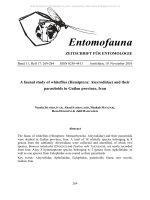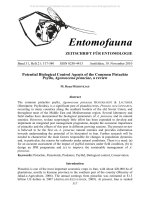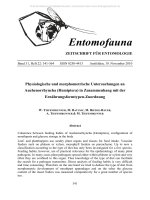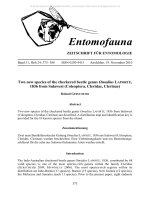Entomofauna, ZEITSCHRIFT FÜR ENTOMOLOGIE VOL 0031-0493-0504
Bạn đang xem bản rút gọn của tài liệu. Xem và tải ngay bản đầy đủ của tài liệu tại đây (2.49 MB, 12 trang )
© Entomofauna Ansfelden/Austria; download unter www.biologiezentrum.at
Entomofauna
ZEITSCHRIFT FÜR ENTOMOLOGIE
Band 31, Heft 32: 493-504
ISSN 0250-4413
Ansfelden, 19. November 2010
Neochalcosia witti sp. n.,
a new Zygaenidae species (Chalcosiinae) from southeast China
(Lepidoptera)
Ulf BUCHSBAUM, Mei-Yu CHEN & Wolfgang SPEIDEL
Summary
A new Zygaenidae species, Neochalcosia witti sp. n,. of the subfamily Chalcosiinae is
described from southeast China and is compared with the two other species of this genus.
The differences are explained and the distribution is shown.
Zusammenfassung
Eine neue Zygaenidae-Art, Neochaclosia witti sp. n. aus der Unterfamilie Chalcosiinae
wird aus Südost-China beschrieben und mit den beiden weiteren Arten dieser Gattung
verglichen. Die Unterschiede werden erläutert und die Verbreitung dargestellt.
493
© Entomofauna Ansfelden/Austria; download unter www.biologiezentrum.at
key words: Lepidoptera, Zygaenidae, Chalcosiinae, Neochalcosia witti sp. n. southeast
China, distribution.
Introduction
Intensive research on the subfamily Chalcosiinae has been carried out during the last ten
or twenty years. During these investigations, many new species could be found and
described (e. g. ENDO & KISHIDA, 1999, HORIE & OWADA, 2000, 2002, KISHIDA &
ENDO, 1999, OWADA, 1996, 2001, OWADA & HORIE, 1999, 2002, YEN, 2003 a, b, 2004,
YEN, ROBINSON & QUICKE, 2005). Furthermore, several important phylogentic and
systematic papers were published about Zygaenidae or some subfamilies of Zygaenidae
(e. g. TARMANN, 1992, YEN et al., 2005, NIEHUIS et al., 2006).
However, so far only very little is known about the biology of many species.
Chalcosiinae
Chalcosiinae is a subfamily of Zygaenidae which is almost restricted to the tropical
Southeast Asian region. About 380 species are known in 70 genera (YEN, 2003).
YEN et al. (2005) and NIEHUIS et al. (2006) deal with the phylogenetic relationship within
the subfamily Chalcosiinae and also with other zygaenid moths.
The genus Neochalcosia was established by YEN & YANG (1997) for the species N.
remota (WALKER, 1862). This species is recorded from China (Sichuan, Shaanxi,
Gansu), Korea, Japan (YEN & YANG, 1997, OWADA et al., 2006) and Taiwan (WANG,
1995). JORDAN (1913) described this species as common. It occurs in parks and habitats
with Quercus species and the hostplants are several Symplocos species (Symplocaceae)
(YEN & YANG, 1997).
OWADA et al. (2006) described a further species from Guangdong, south China., and in
the present paper, a third species is described:
Neochalcosia witti sp. n. (Pl. 1, fig. 1-4)
Holotype ♂: China, Sichuan, Lao Lin Kou, 28°21’ N / 103° 26’ E, 26. VI – 12. VII. 2008, H ~
1900 m NN, leg. Victor Sinyaev. Coll. Museum Witt Munich. Paratypes: 50 ♂♂, 1 ♀ with
same data (2 of them in Coll. ZSM); 1 ♂, China, Szetschwan, Tatsienlu, F. Daniel –
München; Szetschwan, Tatsienlu, Exp. Stötzner; 1 ♂, China, Szetschwan, Tatsienlu, F.
Daniel – München, Coll. ZSM; Szetschwan, Tatsienlu, Exp. Stötzner, Sammlung Osthelder
(in Coll. ZSM); 1 ♂, China, prov. Shaanxi, Tapaishan Mts. (S), Tsinlin Mts., Houbenzi,
33°51’ N / 107°49’E, 1600 m, 1. – 12. VIII. 1999; 1 ♂, China, prov. Shaanxi, Tapaishan
Mts. (S), Tsinlin Mts., Houbenzi, 33°51’ N / 107°49’E, 1600 m, 1. – 12. VIII. 1999, leg. Dr.
Ronald Brechlin;
Description and differential diagnosis:
Wingspan ♂: 42 - 58 mm, Ø 51,95 mm; forewing length 26 – 30 mm, Ø 26,21 mm.
494
© Entomofauna Ansfelden/Austria; download unter www.biologiezentrum.at
Wingspan ♀: 52 mm, forewing length: 28 mm.
Male antenna bipectinate. Female antenna slender and thin. Eyes black. Palpi brown,
short. Legs brownish with some shining blue spots. Body very dark brown. Patagia with
bright red band. Wings brighter brown than body. Forewings with a white band which is
narrower than in the most similar species N. remota (WALKER, 1854). Hindwings also
with a white band from inner margin to vein m3. Basal angle white. This white region is
not confluent with the white band. N. remota and N. nanlingensis OWADA, HORIE &
MIN, 2006 show a large white area covering more than half of the hindwing.. The white
region is not interrupted, and forms a large white dot. White marks in the new species N.
witti are clearer. These marks are more blurred in the species N. remota and N.
nanlingensis.
Male genitalia (pl. 2, fig. 8): Similar to N. remota and N. nanlingensis, but N. witti has a
much stronger and longer ampulla. The uncus tegumen complex is stronger sclerotized
than in the other species. Moreover, the tegumen is distinctively stronger. Vinculum
wider. Aedeagus fully sclerotized, right angled at one third. In the other two species the
right angled part is not sclerotized. Tergit with more distinctively protuberant thorns,
which are also stronger sclerotized. Tergit more slender than in N. remota and conical.
Sternite wide, U-shaped and strongly sclerotized.
Female genitalia (pl. 2, fig. 9): Thin and slender, with long, slender apophyses
posteriores and shorter, stouter apophyses anteriores. Corpus bursae with two signa,
which are weakly sclerotized. Papillae anales less hairy.
Etymology: The new species is dedicated to Mr. Thomas Witt, the founder of the
Museum Witt (Munich), with heartful thanks for his always very good cooperation.
Distribution: N. witti is only known from the localities of the type series in Southeast
China, situated in the provinces Sichuan and Shaanxi (see map).
495
© Entomofauna Ansfelden/Austria; download unter www.biologiezentrum.at
Fig. Map showing the distribution of Neochalcosia witti sp. n.
Discussion
The new species was collected in Southeast China which is known as a biodiversity hot
spot (BROOKS et al., 2002, MYERS et al., 2000, MITTERMEIER et al., 1998). It is named
the Indo-China region, if the Indo-Burmese subregion is included (SEDLAG 1987, 1995).
This region is very diverse especially along and around the Greater Mekong and Yangtze
rivers. Here, many new insect species could be found and described during the last years
(e.g. SCHINTLMEISTER, 2001, BUCHSBAUM, 2006).
References
BROOKS, T. M., MITTERMEIER, R. A. MITTERMEIER, C. G., DA FONSECA, G. A. B., RYLANDS,
A. B., KONSTANT, W. R., FLICK, P., PILGRIM, J., OLDFIELD, S., MAGIN, G. & C. HILTONTAYLORS (2002): Habitat loss and extinction in the hotspots of biodiversity. —
Conservation Biology 16 (4): 909–923.
BUCHSBAUM, U. (2006): Agaristinae (Insecta: Lepidoptera: Noctuidae) of the Himalaya. In:
HARTMANN, M. & J. WEIPERT: Biodiversität und Naturausstattung im Himalaya, 2. —
Erfurt, pp. 119–122, 2 pls.
496
© Entomofauna Ansfelden/Austria; download unter www.biologiezentrum.at
ENDO, T. & Y. KISHIDA (1999): Day-Flying Moths. Chalcosiinae, Epicopeia. Endless
Collection Series 8. — Endless Science Information, Tokyo, 119 pp.
HORIE, K. & M. OWADA (2000): Some Chalcosiine moths of Eterusia (Lepidoptera,
Zygaenidae) from Hainan and Southern China. — Japanese Journal of Systematic
Entomology 6 (1): 19–23.
HORIE, K. & M. OWADA (2002): Systematic position of Chalcosiine moths of Sorita cicinata
and Eterusia culoti (Lepidoptera, Zygaenidae), with description of a new species. —
Tinea, Tokyo 17 (2): 59–66.
JORDAN, K. (1913): Zygaenidae. In SEITZ, A. (Ed.) Die Großschmetterlinge der Erde, 2. pp. 3
– 34. — Alfred Kernen Verlag, Stuttgart.
KISHIDA, Y. & T. ENDO (1999): Description of new species and new subspecies of the
Chalcosiinae (Lepidoptera, Zygaenidae) from South East Asia, with some notes on new
synomies. — Tinea, Tokyo 16 (1): 41–49.
MITTERMEIER, R. A., MYERS, N., THOMSEN, J. B., DA FONSECA, G. A. B. & S. OLIVIERI
(1998): Biodiversity hotspots and major tropical wilderness areas: Approaches to setting
conservation priorities. — Conservation Biology 12 (3): 516–520.
MYERS, N., MITTERMEIER, R. A., MITTERMEIER, C. G., DA FONSECA, G. A. B. & J. KENT
(2000): Biodiversity hotspots for conservation priorities. — Nature 403: 853–858.
NIEHUIS, O., YEN, S.-H., NAUMANN, C. M. & B. MISOF (2006): Higher phylogeny of zygaenid
moths (Insecta: Lepidoptera) inferred from nuclear and mitochondrial sequence data and
the evolution of larval cuticular cavities for chemical defence. — Molecular
Phylogenetics and Evolution 39: 812–829.
OWADA, M. (1996): Two new Chalcosiine Moths (Lepidoptera, Zygaenidae) from Northern
Vietnam. — Bulletin of the National Science Museum, Series A (Zoology) 22 (1): 45–
53.
OWADA, M. (2001): Further notes on geographical forms of the Chalcosiine moth Eterusia
aedea (Lepidoptera, Zygaenidae). — Memoires of the National Science Museum 37:
293–310.
OWADA, M. & K. HORIE (1999): Notes on some Chalcosiine Moths (Lepidoptera,
Zygaenidae) from Indo-Chinese Peninsula, with descriptions of two new species and
two new subspecies. — Japanese Journal of Systematic Entomology 5 (2): 207–216.
OWADA, M. & K. HORIE (2002): Revison of Hampsonia (Lepidoptera, Zygaenidae,
Chalcosiinae) and its allied genera, with description of a new genus and a new species.
— Tinea, Tokyo 17 (2): 49–58.
OWADA, M., HORIE, K. & M. WANG (2006): A new moth of the genus Neochalcosia
(Lepidoptera, Zygaenidae, Chalcosiinae) from Nanling Mountains, Guangdong, with
notes on the daily behaviour of male Neochalcosia. — Tinea, Tokyo 19 (2): 129–136.
SCHINTLMEISTER, A. (2001): New and less known Notodontidae from mainland China
(Insects, Lepidoptera, Notodontidae). — Neue Entomologische Nachrichten 50: 1–141,
20 pls.
SEDLAG, U. (1984): Wörterbücher der Biologie. Biogeographie, Artbildung, Evolution. —
Gustav Fischer Verlag, Jena, 333 pp.
SEDLAG, U. (1995): Urania Tierreich. Tiergeographie. — Urania Verlag, Leipzig, Jena Berlin,
447 pp.
497
© Entomofauna Ansfelden/Austria; download unter www.biologiezentrum.at
TARMANN, G. M. (1992): A revision of the Arbudas-complex (sensu Hering 1922) and the
description of a new androconial organ (Zygaenidae: Chalcosiinae). — Heterocera
Sumatrana 7 (1): 21–77.
WANG, H. Y. (1995). Guide book to Insects in Taiwan, 12. Zygaenid moths and some other
day-flaying moths. — Taipei, 126 pp. (in chinese)
YEN, S.-H. (2003a): A new species of Eterusia Hope, 1841 (Lepidoptera: Zygaenidae,
Chalcosiinae) from Mindanao and Seram. — Entomologische Zeitschrift, Stuttgart 113
(4): 121–126.
YEN, S.-H. (2003b): Phylogenetic relationships and biogeography of Agalopini Alberti, 1954
(Lepidoptera, Zygaenoidea, Zygaenidae sensu lato). — Journal of the Zoological
Society Wallacea 1: 27–28.
YEN, S.-H. (2004): Nomenclatural and systematic problems surrounding Eterusia aedea
(Linnaeus, 1763) (Lepidopotera: Zygaenidae: Chalcosiinae). — Zoological Studies 43
(1): 20–34.
YEN, S.-H., ROBINSON, G. S. & D. L. J. QUICKE (2005): Phylogenetic relationships of
Chalcosiinae (Lepidoptera, Zygaenoidea, Zygaenidae). — Zoological Journal of the
Linnean Society 143: 161–341.
YEN, S.-H. & P.-S. YANG (1997): Two new genera of Chalcosiinae (Zygaenidae) from eastern
Palaearctic Asia. — Transactions of the Lepidopterological Society of Japan 48 (4):
243–263.
Plate 1
Fig. 1. Neochalcosia witti BUCHSBAUM, CHEN & SPEIDEL sp. n. ♂. Painting by Ruth
KÜHBANDNER.
Fig. 2. Neochalcosia witti Buchsbaum, Chen & Speidel sp. n. Holotype ♂ “China –
Sichuan,; Lao Lin Kou; 28° 21’ N * 103°26’ E; 26. 06. – 12. 07. 08 H ~ 1900 m; legit
Vitor Sinyaev, Coll. Museum Witt”
Fig. 3. Neochalcosia witti BUCHSBAUM, CHEN & SPEIDEL sp. n. ♂, underside. Paratype,
same data as holotype.
Fig. 4. Neochalcosia witti BUCHSBAUM, CHEN & SPEIDEL sp. n. ♀. Paratype, same data
as holotype.
Fig. 5. Neochalcosia remota (WALKER, 1854) ♂ “Japan, Pref. Shiga, Mt Hira, 1214, 23.
VIII 57, leg. S. Ishida, Staatsslg. München”
Fig. 6. Neochalcosia remota (WALKER, 1854) ♂, underside, same data as fig. 4.
Fig. 7. Neochalcosia remota (WALKER, 1854) ♀ “Japan, Kyoto, Kurama, 14. VII. 36,
Staatssamml. München”
498
© Entomofauna Ansfelden/Austria; download unter www.biologiezentrum.at
499
© Entomofauna Ansfelden/Austria; download unter www.biologiezentrum.at
Plate 2
Fig. 8. Male genitalia of Neochalcosia witti BUCHSBAUM, CHEN & SPEIDEL sp. n.
Fig. 9. Female genitalia of Neochalcosia witti BUCHSBAUM, CHEN & SPEIDEL sp. n.
500
© Entomofauna Ansfelden/Austria; download unter www.biologiezentrum.at
501
© Entomofauna Ansfelden/Austria; download unter www.biologiezentrum.at
Authors addresses:
Ulf BUCHSBAUM
Zoologische Staatssammlung München
Münchhausenstraße 21
D - 81247 München
Germany
E-mail:
Mei-Yu CHEN
Lustheimstraße 5
D - 81247 München
Dr. Wolfgang SPEIDEL
Zoologische Staatssammlung München
Münchhausenstraße 21
D - 81247 München
Germany
E-mail:
502
© Entomofauna Ansfelden/Austria; download unter www.biologiezentrum.at
Buchbesprechungen
BUSE, J., ALEXANDER, K.N.A., RANIUS, T., ASSMANN, T. (eds): Saproxylic Beetles Their role and diversity in European woodland and tree habitats. - Pensoft, SofiaMoscow, 2009. 235 S.
The group of saproxylic beetles consists of thousands of different species exhibiting a
rich variety of form as well as varied life-cycle strategies. They play an important role in
decomposition processes and thus for nutrient-cycling in natural ecosystems. Based on
contributions given at the conference this book contains contributions about research on
conservation ecology of saproxylic beetles as well as results from recent faunistic
surveys in different European regions. It comprises aspects of saproxylic beetle ecology,
faunistics, diversity and conservation issues. International experts report on their activity,
management strategies and new approaches in saproxylic insect conservation. There are
a lot of people doing research on saproxylic beetles in different countries of the world,
but this seems to be a little bit disorganized. Hopefully, these European conferences will
lead to a better, more international network.
The contributions included in this volume cover a broad spectrum of research on
saproxylic beetles, organized in three main chapters: “Saproxylic beetle assemblages and
regional surveys” include “Oaks in Norway”, showing the abundance and composition of
red-listed species of beetles in hollow oaks. Further reports on regional surveys deals
with a spruce primeval forest in Romania, a hardwood floodplain forest in the Czech
Republic, and the Gartow region of Lower Saxony, a hotspot of saproxylic beetle
diversity in north-western Germany. “Saproxylic beetle ecology and implications for
their conservation” deals with ecological studies of single species, e.g. Limoniscus
violaceus, Lucanus cervus, Osmoderma eremita and the worldwide distribution of the
genus Cucujus. “Advances in methodology and databases” discusses new techniques in
trapping and the development of databases.
This volume gives a nice overview of the actual research on saproxylic beetles in Europe
and I wish the next conference in 2010 a successful meeting; maybe some people from
the UK or even overseas should be invited.
This book can be directly ordered at www.pensoft.net.
R. Gerstmeier
LESCHEN, R.A.B., BEUTEL, R.G., LAWRENCE, J.F. (Eds): Handbook of Zoology;
Arthropoda: Insecta. Coleoptera, Beetles. Morphology and Systematics. Vol. 2. - Walter
de Gruyter, Berlin/New York, 2010. 786 S.
Fünf Jahre nach Erscheinen des ersten Bandes über Morphologie, Taxonomie und
Biologie der Käfer (weltweit) liegt nun der 2. Band vor, welcher die Taxa Elateroidea,
Derodontiformia, Bostrichiformia und Cucujiformia beinhaltet. Insgesamt werden in
diesem Teilband 101 Familien behandelt. Es wurden einige Änderungen in der
Klassifikation von Familien und Unterfamilien vorgenommen, die hier nicht im
einzelnen dargestellt werden sollen. Bemerkt wird lediglich die Etablierung der
503
© Entomofauna Ansfelden/Austria; download unter www.biologiezentrum.at
Derodontiformia, mit den Familien Derodontidae, Nosodendridae und Jacobsoniidae.
Eine Übersicht hierzu gibt das erste Kapitel “Changes in classification and list of
families and subfamilies”. Das zweite Kapitel “Glossary of Morphological Terms” liefert
einen ersten Einstieg in eine einheitliche Terminologie adulter und larvaler
morphologischer Begriffe. Die für die nächsten beiden Bände angedeutete Fortsetzung
und Erweiterung dieser Begriffe wäre überaus wichtig und wünschenswert. Gegenüber
dem ersten Band muss nun die einheitlichere redaktionelle Bearbeitung gelobt werden;
abgesehen von den Aspidytidae gibt es nun zu allen Familien zumindest eine
Gesamthabitus-Abbildung und auch die Artenzahlen werden für die einzelnen Familien
angegeben. Fantastisch sind die gezeichneten Tafeln von Imagines, Larven und
morphologischen Detailstrukturen der Elateridae und Tenebrionidae.
Mit dem zweiten Band der Käfer wurde nun in der Tat die hohe Qualität eines
“Handbuches” erreicht. Mit Spannung dürfen jetzt die Bände 3 (Phytophaga) und 4
(special topics of morphology, natural history, and evolution) erwartet werden.
R. Gerstmeier
Druck, Eigentümer, Herausgeber, Verleger und für den Inhalt verantwortlich:
Maximilian SCHWARZ, Konsulent f. Wissenschaft der Oberösterreichischen Landesregierung, Eibenweg 6,
A-4052 Ansfelden, E-Mail:
Redaktion: Erich DILLER, ZSM, Münchhausenstraße 21, D-81247 München;
Roland GERSTMEIER, Lehrstuhl f. Tierökologie, H.-C.-v.-Carlowitz-Pl. 2, D-85350 Freising;
Fritz GUSENLEITNER, Lungitzerstr. 51, A-4222 St. Georgen/Gusen;
Wolfgang SCHACHT, Scherrerstraße 8, D-82296 Schöngeising;
Wolfgang SPEIDEL, MWM, Tengstraße 33, D-80796 München;
Thomas WITT, Tengstraße 33, D-80796 München.
Adresse:
Entomofauna, Redaktion und Schriftentausch c/o Museum Witt, Tengstr. 33, 80796 München,
Deutschland, E-Mail: ; Entomofauna, Redaktion c/o Fritz Gusenleitner,
Lungitzerstr. 51, 4222 St. Georgen/Gusen, Austria, E-Mail:
504









